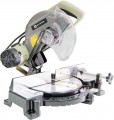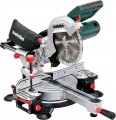Power
Saw motor power in watts. For petrol tools (see "Power Source"), horsepower is additionally indicated, see below for details.
The higher the power, the better the tool is suitable for voluminous work and hard materials, the greater the depth of cut it can provide and the easier it can cope with significant loads. In addition, for different types of saws and different types of materials, the actual power values \u200b\u200bcan also be different. For example, a power of
2.5 – 3 kW is actually the limit for
chain saws, but in
chain saws this is an average figure, among such tools there are models of
3 – 4 kW and even
more. Detailed selection recommendations for various cases can be found in special sources.
No load blade speed
The maximum speed of the disk, provided by a saw of the appropriate design — disk, cut-off, etc. (see "Device").
Note that most of these saws use gearboxes, so that the blade revolutions are much lower than the engine revolutions (see above). This achieves an increase in torque, which in the case of saws is often more important than the high speed of the blade.
As for the specific number of revolutions, it is first of all worth noting that only saws with the same disc diameter can be compared according to this indicator. In these cases, higher speeds provide better performance, but the trade-off is reduced torque; such saws do better with relatively "light" materials. Conversely, low speeds reduce productivity, but allow the blade to effectively "bite" even into dense, stubborn workpieces. More specific recommendations regarding the choice of a saw according to the number of revolutions of the blade can be found in special sources.
Bar/blade size
The largest tyre size (in chain saws) or disc (in circular saws and some others, see "Device") that is allowed for this tool. Tyres are sized by working length, rims by diameter.
A larger bar/wheel allows for deeper cuts but requires more powerful motors. Therefore, this parameter cannot be exceeded — this can lead to an overload of the engine with all the corresponding troubles. However, in many models with a disc it is physically impossible to install a nozzle with a diameter larger than the maximum allowable.
Also note that saws with similar bar/blade sizes may differ in maximum depth of cut (mostly due to differences in design or power). As for the specific dimensions, they depend on the type of saw (see "Device"). For example, large discs of
450 – 500 mm are found exclusively in stationary chain saws, the maximum figure for cutting models is
400 – 450 mm, for trimming —
300 – 350 mm, and sizes of
500 – 550 mm or
more clearly indicate that speech It's about a chainsaw chainsaw bar. Detailed recommendations regarding the choice of a tool for a given size can be found in special sources.
Bore diameter
The diameter of the mounting hole for which the blade holder in the saw of the corresponding design is designed (see "Device"). In fact, this paragraph indicates the diameter of the axis on which the disk is installed — this size should correspond to the hole in the disk itself.
Note that some models of saws allow the installation of discs with larger holes than indicated in the specifications — when using an adapter sleeve. The main thing is that the own diameter of the disk does not exceed the values \u200b\u200ballowed for this model (see "Tyre / disk diameter"). Popular sizes include
20mm,
25mm and
30mm.
Cutting depth
The greatest depth of cut provided by the saw.
In most types of saws (see “Device”), the depth of cut directly depends on both the engine power and the size of the tyre / disk. The specifications give a value for the maximum allowable size of the working nozzle; when using nozzles of a smaller size, the depth of cut, respectively, will be less. But in band saws, this depth is rather weakly related to the actual length of the tape — it is determined primarily by the length of the open section of the tape, which is directly involved in the work.
Anyway, the greater depth of cut makes the tool more versatile, but comes at the cost of weight, price, and electricity/fuel consumption. So when choosing, it is worth considering the real features of the planned work and the dimensions of the workpieces that are planned to be cut. As for specific values, the most modest tools provide a depth
of up to 50 mm ;
50 – 75 mm is considered a low indicator,
75 – 100 mm is average,
100 – 125 mm is above average,
125 – 150 mm is already quite an impressive thickness, and the most powerful modern saws can have a cutting depth
of more than 150 mm.
Cutting depth (45° angle)
Maximum cutting depth achieved when sawing at a 45° bevel.
This feature is indicated only for those models that are originally designed for sawing at an angle — for example, due to the special design of the attachment for the blade / blade (in stationary models, see "Type") or due to the inclined support platform (in manual) . The maximum angle of inclination of the saw in such models can be different (see below for more details), however, 45 ° is considered the standard option, so it is for this inclination that data on the depth of cut is given.
The general meaning of this parameter is quite obvious. On the one hand, a greater depth of cut allows you to cope with thicker workpieces and generally gives you more options; on the other hand, an increase in depth requires an increase in the size of the disk / canvas and an increase in power, which, accordingly, affects the price, dimensions and consumption of electricity / fuel.
Cutting width
The kerf width determines the maximum size of the cutting line, and therefore the maximum width of the workpiece that the saw can cut through in one go. The value of the kerf width depends primarily on the diameter of the saw blade. Additionally, the stroke of the broach mechanism should also be taken into account. Saws with a pulling mechanism provide a cut that exceeds the diameter of the cutting blade.
Saw angle
The maximum angle at which the working part of the saw can be tilted relative to the vertical. It can be indicated not only for stationary tools, but also for manual ones — in the event that the design provides for a support platform. It is worth paying attention to this parameter if you have to deal with oblique cuts: making such cuts by setting the saw to a certain angle is much more convenient than adjusting this angle manually.
Saw angle
The largest angle at which the working part of the saw can be rotated relative to the standard position (note that we are not talking about tilt, but about turning from side to side). This feature is often found in miter saws (see Device) which are not limited to straight cuts; turning the saw is the most convenient, and sometimes the only way to cut the workpiece obliquely.

